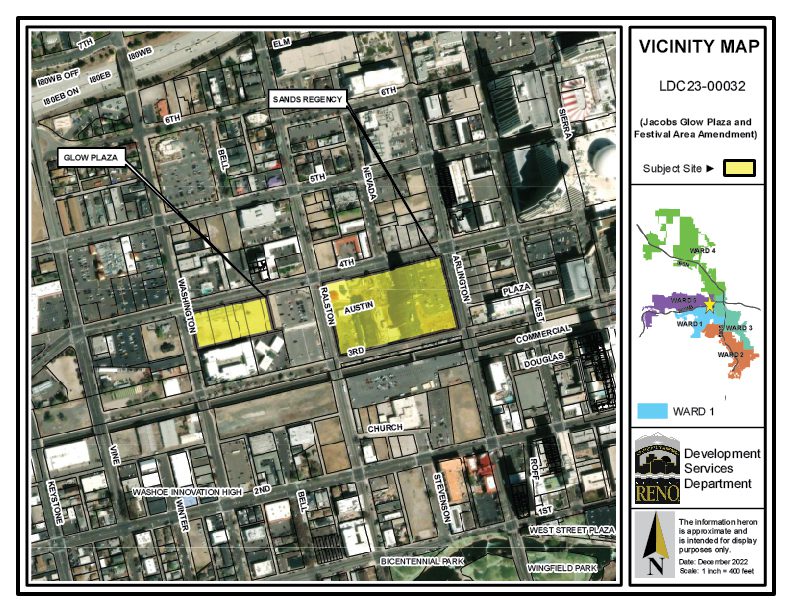
Planning Commission Approves Glow Plaza Request
With little regard for Reno’s sign codes, the Planning Commission in a 5-1 vote approved an amended permit February 1 that will allow Jeff Jacobs’ Glow Plaza festival grounds to advertise events on his giant digital Sands’ casino sign when completed – something that has never been sanctioned in Reno until now.
Casinos are allowed almost unlimited digital signage, but those displays are restricted to ads for goods and services sold onsite. That restriction was obvious in the city’s approval for Jacobs’ digital sign last fall where it said, “please note the digital displays can only advertise onsite activity.”
Yet Sands owner and land developer Jeff Jacobs moved forward this year with his request to allow Glow Plaza ads on his soon-to-be-completed Sands’ mega digital sign facing west Fourth street which was approved by the commission majority.
Commission Chair Alex Velto quoting from the city’s Master Plan to encourage casinos in the entertainment district said, “we should be doing everything we can to encourage (the Glow Plaza) consistent with the Master Plan.” Commissioner Mark Johnson, who voted no, replied that while the Master Plan does support a thriving downtown that doesn’t mean it supports “monumental signage.”
“There’s not a single mention about that support (of the Master Plan) being based on approving digital signage to let everyone know what’s going on down there,” Commission Johnson said. “I feel that encouragement can be done with things other than monumental signage.” Click here to view the hearing.
City Officials Buy into the Work Around
The trick used to avert the ban on digital billboards and get around the approved sign application was to amend the Glow Plaza boundaries to include the Sands property. That way, according to city staff, the Sands can advertise Glow Plaza festival events because both businesses are on the same site. City code doesn’t allow off-premises ads on casino and other business signs only ads for goods and services sold on the premises.

The commission majority believed that redrawing the boundary to encompass both premises which aren’t even contiguous makes everything okay. However, both the Sands and the Glow Plaza are still separate and unique premises with different regulations and approved uses. Namely, the Sands is a gaming facility with unlimited signage and the Glow Plaza is a festival venue with sign limits. The Sands can’t host festival events and the Glow Plaza can’t provide gaming. Under the sign code, the Glow Plaza is entitled to a 25-foot tall, 125 square foot digital sign with full video animation. But, apparently, that wasn’t enough for Jeff Jacobs.
According to the approved permit application, the largest Sands sign will be 4,242 square feet and built high up on the north-facing façade set back from Fourth Street. As a comparison, the giant GSR digital casino sign that has irked residents for years, is 4,135 square feet at 44 feet wide and 94 feet tall.

With this decision only the Glow Plaza is receiving the unfair advantage that is contrary to Reno’s sign code. No other business on the west Fourth Street corridor or anywhere else in Reno (except casinos) can have access to giant digital signs for now.
Decision Dilutes Sign Code Protections
At the hearing in February, Scenic Nevada pointed out that this case poses the danger of a slippery slope. Other digital sign owners may want to advertise off premise ads on their business signs for one reason or another. Or existing billboard owners may want to change from standard to digital lighting, which is prohibited in Reno, except for billboards owned by the tribes. Our concern is that the city will continue to dilute our sign codes meant to protect us from sign clutterand flashing digital signs every time there’s a request.
For decades nationwide communities have created distinctions between billboards and business signs by defining them and then regulating size, height and lighting in code. A billboard, or off-premises sign, is one that displays ads for goods and services not sold on the premises. A regular business sign (on-premises sign), like the ones for casinos, can only display goods and services sold on the premises. Allowing both on and off-premises ads on one sign, as in this case, blurs the distinctions between the two types of signs.
The other digital Sands’ sign is 2,631 square feet and will wrap around the Sands building closer to Arlington Street where the Mel’s Diner sign was located. Combined value is $5 million, according to the sign application.
The signs are not only big but can be unreasonably bright. The Reno Sign Code says digitals can have a nighttime brightness level of 1,500 nits. The higher number of nits, the brighter the sign. According to its website, the International Dark Skies Association recommends 80 nits in an urban setting at night.
Is the Sands sign a billboard because it will advertise off-premises events? We think so and that’s why we opposed Jacobs’ request. Reno sign codes prohibit new billboards within the city limits. The approval also is contrary to the on-premises sign code where it says only casinos can have the giant digital signs that can blast changing video messages 24/7. With this approval now a non-casino – the Glow Plaza festival grounds – has a giant digital sign within its property boundaries to post its ads.
The commission’s decision is final because there was no appeal to the Reno City Council.
The flimsy work-around concocted by Jacobs should have been denied. Reno voters cast ballots over 20 years ago to prohibit the new construction of billboards to stop clutter and reduce blight. Jacobs with the city’s help was able to dimmish that vote showing very little respect for the voters’ wishes and the scenic character of our community – all for the purpose of promoting Jacobs’ festival events on a casino sign.